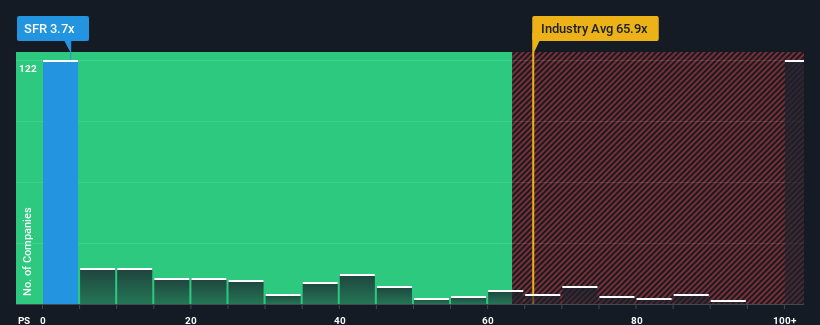- Australia
- /
- Metals and Mining
- /
- ASX:SFR
Sandfire Resources Limited (ASX:SFR) Shares Fly 26% But Investors Aren't Buying For Growth
The Sandfire Resources Limited (ASX:SFR) share price has done very well over the last month, posting an excellent gain of 26%. The last 30 days bring the annual gain to a very sharp 74%.
Although its price has surged higher, Sandfire Resources may still be sending very bullish signals at the moment with its price-to-sales (or "P/S") ratio of 3.7x, since almost half of all companies in the Metals and Mining industry in Australia have P/S ratios greater than 65.9x and even P/S higher than 289x are not unusual. Nonetheless, we'd need to dig a little deeper to determine if there is a rational basis for the highly reduced P/S.
View our latest analysis for Sandfire Resources

What Does Sandfire Resources' P/S Mean For Shareholders?
Recent times haven't been great for Sandfire Resources as its revenue has been rising slower than most other companies. It seems that many are expecting the uninspiring revenue performance to persist, which has repressed the growth of the P/S ratio. If this is the case, then existing shareholders will probably struggle to get excited about the future direction of the share price.
If you'd like to see what analysts are forecasting going forward, you should check out our free report on Sandfire Resources.Is There Any Revenue Growth Forecasted For Sandfire Resources?
Sandfire Resources' P/S ratio would be typical for a company that's expected to deliver very poor growth or even falling revenue, and importantly, perform much worse than the industry.
Taking a look back first, we see that the company grew revenue by an impressive 16% last year. The latest three year period has also seen an excellent 54% overall rise in revenue, aided by its short-term performance. So we can start by confirming that the company has done a great job of growing revenue over that time.
Shifting to the future, estimates from the analysts covering the company suggest revenue should grow by 14% each year over the next three years. Meanwhile, the rest of the industry is forecast to expand by 542% per annum, which is noticeably more attractive.
With this information, we can see why Sandfire Resources is trading at a P/S lower than the industry. Apparently many shareholders weren't comfortable holding on while the company is potentially eyeing a less prosperous future.
What We Can Learn From Sandfire Resources' P/S?
Shares in Sandfire Resources have risen appreciably however, its P/S is still subdued. Typically, we'd caution against reading too much into price-to-sales ratios when settling on investment decisions, though it can reveal plenty about what other market participants think about the company.
As expected, our analysis of Sandfire Resources' analyst forecasts confirms that the company's underwhelming revenue outlook is a major contributor to its low P/S. Shareholders' pessimism on the revenue prospects for the company seems to be the main contributor to the depressed P/S. It's hard to see the share price rising strongly in the near future under these circumstances.
Many other vital risk factors can be found on the company's balance sheet. Our free balance sheet analysis for Sandfire Resources with six simple checks will allow you to discover any risks that could be an issue.
If strong companies turning a profit tickle your fancy, then you'll want to check out this free list of interesting companies that trade on a low P/E (but have proven they can grow earnings).
New: Manage All Your Stock Portfolios in One Place
We've created the ultimate portfolio companion for stock investors, and it's free.
• Connect an unlimited number of Portfolios and see your total in one currency
• Be alerted to new Warning Signs or Risks via email or mobile
• Track the Fair Value of your stocks
Have feedback on this article? Concerned about the content? Get in touch with us directly. Alternatively, email editorial-team (at) simplywallst.com.
This article by Simply Wall St is general in nature. We provide commentary based on historical data and analyst forecasts only using an unbiased methodology and our articles are not intended to be financial advice. It does not constitute a recommendation to buy or sell any stock, and does not take account of your objectives, or your financial situation. We aim to bring you long-term focused analysis driven by fundamental data. Note that our analysis may not factor in the latest price-sensitive company announcements or qualitative material. Simply Wall St has no position in any stocks mentioned.
About ASX:SFR
Sandfire Resources
A mining company, explores for, evaluates, and develops mineral tenements and projects.
Adequate balance sheet with moderate growth potential.
Similar Companies
Market Insights
Community Narratives



